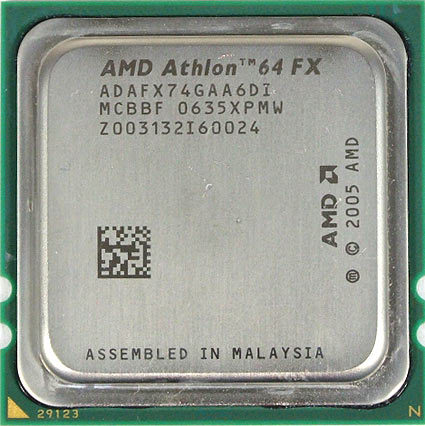AMD's 4x4 Platform & Athlon 64 FX-70 - Brute Force Quad Cores
Buying FX-70 Means You Buy Two Processors
The overall concept behind Quad FX is clear: "if we cannot provide a real quad core now, let's go and build something bigger with what we have." The result is three new processor products, all based on existing technology. If you purchase an Athlon 64 FX-70 ($599), FX-72 ($799) or FX-74 ($999), you will be buying two physical processors running at 2.6 GHz, 2.8 GHz or 3.0 GHz, respectively. Socket AM2 does not support more than a single processor socket, so AMD simply pulled the professional Socket 1207 off of the Opteron shelf to power Quad FX. So far, there is only one motherboard that will be available to support the new FX-70 series, but before we get to it, let's dig into Quad FX step by step.
Still The Good Old 90 nm Windsor/Egypt Dual Core
There is not much news on the CPU front: AMD uses existing designs and adjusted packages and ratings for Quad FX. Windsor is the codename for the Athlon 64 X2 and Athlon 64 FX dual core at 90 nm with 1 MB L2 cache per processor core. Egypt is the Opteron counterpart, which offers two more HyperTransport links and requires registered DDR2 memory. Apart from that, these two parts are like close siblings.
AMD deploys dual stress liner technology (DSL) in its silicon on insulator (SOI) process. DSL allows the chips to run higher clock speeds, and the insulator layers are used to oppose electromigration, which causes leakage currents and increases processor temperatures. Using DSL SOI, AMD was able to hit the 3 GHz mark with its latest products. However, there is not much headroom left: even overclocked to just slightly over 3.1 GHz, our test system crashed.
AMD FX-70 Models: Available At Up To 3 GHz
Some people didn't expect AMD to release the Athlon 64 FX-62 at 2.8 GHz until spring, but now AMD has proven that the 90 nm process is good enough to reach even higher clock speeds. The FX-74 is specified to run a core clock speed of 3.0 GHz and thus is the fastest AMD processor product ever.
| Model | Clock | HT Speed | Package | Voltage | Max. Case Temp | TDP | L2 Cache |
|---|---|---|---|---|---|---|---|
| FX-70 | 2.6 GHz | 1 GHz bi-directional | LGA 1207 | 1.35-1.4 V | 55-63°C | 125 W | 1+1 MB |
| FX-72 | 2.8 GHz | 1 GHz bi-directional | LGA 1207 | 1.35-1.4 V | 55-63°C | 125 W | 1+1 MB |
| FX-74 | 3.0 GHz | 1 GHz bi-directional | LGA 1207 | 1.35-1.4 V | 56°C | 125 W | 1+1 MB |
Get Tom's Hardware's best news and in-depth reviews, straight to your inbox.
Current page: Buying FX-70 Means You Buy Two Processors
Prev Page Who Needs Two Processors And Four Cores Anyway? Next Page Two Processors = Double The Power Requirements
Patrick Schmid was the editor-in-chief for Tom's Hardware from 2005 to 2006. He wrote numerous articles on a wide range of hardware topics, including storage, CPUs, and system builds.



